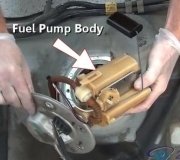It's supposed to run for one second, then turn off. That's the safety feature to turn it off if a fuel line is ruptured in a crash, so it doesn't dump raw fuel on the ground and create a fire hazard. The Engine Computer will turn it on again when it sees engine rotation, (cranking or running). It knows that by the pulses from the crankshaft position sensor and the camshaft position sensor.
How long you have to crank the engine will determine whether you have a problem to worry about. If you're talking about three or four seconds, that is likely due to a leaking injector, and can be ignored. My '88 Grand Caravan has done that for the last 15 years when it's warm. Fuel pressure normally will hold for weeks, but with a leaking injector, fuel pump check valve, or pressure regulator, the pressure bleeds down to 0 psi within minutes of stopping the engine. That one-second spurt from the fuel pump usually isn't long enough to get the pressure up to what's needed for starting, and battery voltage is drawn down a lot during cranking so the pump runs slower than normal. The pressure has to slowly build up while you're cranking the engine. To verify if low pressure is the cause of the long crank time, turn the ignition switch to "run", wait for that priming pulse, turn it off, then do that again. The fuel pressure will be higher and the engine will start sooner.
Also be aware that if an injector is leaking, that cylinder will be flooded, and that can also make the engine take longer to start. My engine starts instantly when it's cold and the pressure has bled down overnight, but it has a long crank time when it is warmed up and still has good pressure.
Wednesday, June 25th, 2014 AT 7:25 PM




